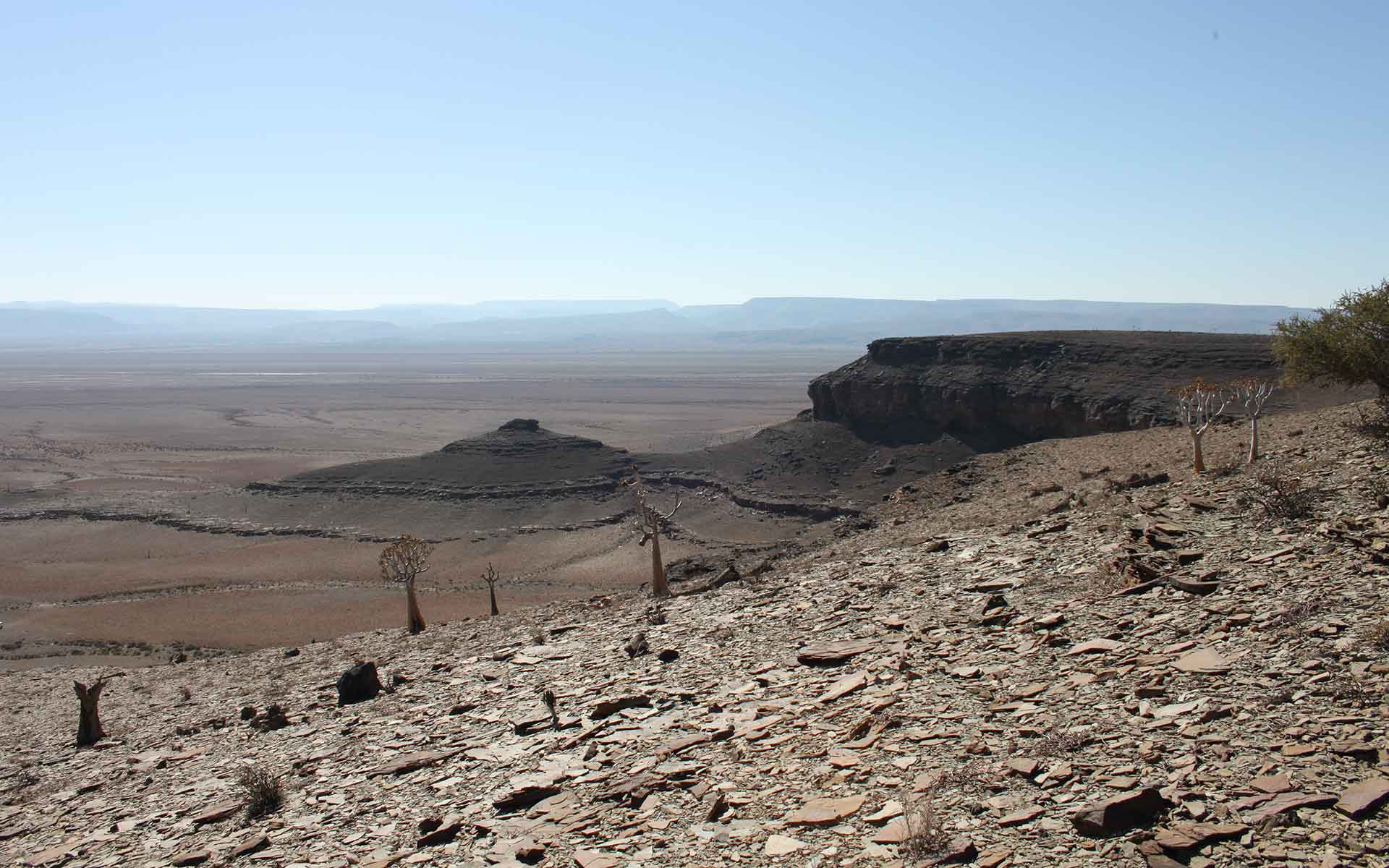
View from Swartpunt mountain.
Geological Period
Ediacaran to Cambrian
Main geological interest
Paleontology
Stratigraphy and sedimentology
Location
Karas and Hardap Regions, Namibia
26°43’56”S, 016°29’59”E
View from Swartpunt mountain.
One of the most continuous stratigraphic and paleontological records with crucial information to understand the evolution of complex life during the Ediacaran-Cambrian time interval.
The Ediacaran-Cambrian transition (~550-538 million years ago) marks one of the most important geobiological revolutions in Earth history with the appearance of biological and ecological innovations that continue to dominate marine ecosystems into the present day. The Nama Group records this interval in unparalleled extent, including exquisitely preserved fossils that are helping us reconstruct the origin of modern-looking marine ecosystems. Among many other aspects, Nama Group fossils record the advent of calcified skeletons, the first appearance of complex bioturbation, and the rise of benthic suspension feeding – all behaviors that arguably form part of the ‘fuse’ for the subsequent Cambrian explosion.
- Geological description
The Ediacaran to Cambrian-aged Nama Group is a >3000 meter thick succession of interbedded shallow marine carbonates and siliciclastics, deposited on an extensive peneplain on the southern foreland of the Damara Orogen as part of the Neoproterozoic pan-African orogeny (Germs, 1983). In the present day, the Nama Basin extends over 1000 km from Gobabis in the north to the banks of the Orange River in the south, and is subdivided into 3 subbasins – the Witvlei, Zaris, and Witputs. The succession preserves numerous, iconic fossil deposits that have been studied since the 1930’s. Quartzites belonging to the Dabis Formation on Farms Aar, Plateau and Pockenbank contain enigmatic soft-bodied fossils that continue to influence debate surrounding the early evolution of animals. In the north, Farms Omkyk and Driedoornvlagte host extensive reef tracts that include the oldest calcifying metazoans (Grotzinger et al., 2000; Penny et al., 2014). Higher in the stratigraphic column, the Urusis Formation on Farm Swartpunt preserves among the youngest Ediacaran fossils in the world, alongside complex trace fossils that augur the beginning of the Cambrian substrate revolution (Narbonne et al., 1997). Radiometric dating of ash beds in the succession provides geochronological context for these fossils, helping to refine the age of the Ediacaran-Cambrian boundary (Linnemann et al., 2019).
- Scientific research and tradition
Fossils in the Nama Group were discovered by geologists in the early 20th century, following reports made by German soldiers stationed in the Aus region. This has led to intensive geological research that has placed the Nama Group at the forefront of debates surrounding the Precambrian evolution of animals and dynamics of the Ediacaran-Cambrian transition.
- Reference
Germs, G.J.B. (1983) ‘Implications of a sedimentary facies and depositional environmental analysis of the Nama Group in South West Africa/Namibia’, Evolution of the Damara Orogen. Special Publication of the Geological Society of South Africa. Edited by R.M. Miller, (11), pp. 89–114.
Linnemann, U. et al. (2019) ‘New high-resolution age data from the Ediacaran–Cambrian boundary indicate rapid, ecologically driven onset of the Cambrian explosion’, Terra Nova, 31(1), pp. 49–58. Available at: https://doi.org/10.1111/ter.12368.
Narbonne, G.M., Saylor, B.Z. and Grotzinger, J.P. (1997) ‘The youngest Ediacaran fossils from southern Africa’, Journal of Paleontology, 71(6), pp. 953–967. Available at: https://doi.org/10.1017/s0022336000035940.
Penny, A.M. et al. (2014) ‘Ediacaran metazoan reefs from the Nama Group, Namibia’, Science, 344(6191), pp. 1504–1506.
- Author(s)
Helke Mocke.
Geological Survey of Namibia, Namibia.
Rachel Wood.
University of Edinburgh, Scotland.
Patricia Vickers-Rich.
Swinburne University of Technology, and Monash University, Australia.
Ulf Linnemann.
Senckenberg Research Institute, Germany.
Simon Darroch.
Senckenberg Institute and Museum of Natural History, Germany.
Mike Hall.
Monash University, Australia.
Guy M. Narbonne.
Department of Geological Sciences and Geological Engineering, Queens University, Kingston, ON Canada.
Alan Jay Kaufman.
University of Maryland, USA.
Marc Laflamme.
University of Toronto, Canada.
Alexander G. Liu.
University of Cambridge, United Kingdom.
Fred Bowyer.
University of Edinburgh, Scotland.
Mandy Zieger-Hofmann.
Senckenberg Research Institute, Germany.
Karl-Heinz Hoffmann.
Private Consultant, Windhoek, Namibia.
Gabi Schneider.
Namibia Uranium Institute, Namibia.
Peter Swinkels.
Private Consultant, Australia.
Kombada Mhopjeni.
Geological Survey of Namibia, Namibia.
Freddy Muyamba.
Geological Survey of Namibia, Namibia.


